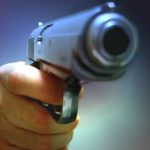 I read an article the other day that surprised me. It was about self-defense killings and it said that the number of shootings described as self-defense in this country has doubled since 2000. (More Killings Called Self Defense WSJOnline 04/02/2012) Per FBI crime statistics there were 176 reported self-defense killings in 2000 and 326 in 2010. The article points to “stand your ground” laws in many states, laws that cover an armed citizen and say that you don’t have to retreat if you feel threatened, you can defend yourself.
I read an article the other day that surprised me. It was about self-defense killings and it said that the number of shootings described as self-defense in this country has doubled since 2000. (More Killings Called Self Defense WSJOnline 04/02/2012) Per FBI crime statistics there were 176 reported self-defense killings in 2000 and 326 in 2010. The article points to “stand your ground” laws in many states, laws that cover an armed citizen and say that you don’t have to retreat if you feel threatened, you can defend yourself.
(I have to insert a disclaimer here, I believe in gun ownership and that if a person does own a gun its incumbent upon that person to be responsible with the weapon).
I don’t have a problem with people defending themselves and people they love from criminals. That being said, I would hope that anyone who points a gun at someone in a situation is certain that deadly force is the last and only resort available. They can’t have a television mentality about waving a gun around. On TV that might scare someone and diffuse a situation; in real life it will only escalate things and someone is likely to end up dead. That’s why it’s called deadly force. One lesson I have always remembered from firearms training in the police academy was an admonition about drawing your duty weapon. I’m paraphrasing, but it went something like this: If you draw your weapon and point it at someone, be prepared to shoot them. And understand the consequences.
Police officers are not trained to draw their weapons to scare people, to fire warning shots, or to bully people. Officers draw their weapons in life threatening situations to stop an immediate threat. And, when an officer discharges a weapon at someone believed to be an immediate threat to them or an innocent person the officer must be able to articulate the threat perceived clearly and unambiguously. Often an officer has less than the blink of an eye to decide whether or not to shoot and his decision will be debated ad infinitum by lawyers and armchair quarterbacks for years afterward.
A well placed bullet stops a beating heart and when I was on the job I knew that if the situation ever arose for me, I’d need to be certain I was able to justify my actions for my own peace of mind.
Retired now, as a civilian I have a CCW and still carry a weapon on occasion. I’ve often thought about what might prompt me to draw the handgun I carry: It’s the same as when I was working. I’d have to perceive a real threat in order to draw my gun and be absolutely certain it was the last resort before pulling the trigger.
But my first choice would always be 911. Uniformed police officers are continually trained to deal with any and all threats that come their way. They have resources, equipment, training, and mind set to do the best job in an emergency situation.
Thank you for your sharing. I am worried that I lack creative ideas. It is your article that makes me full of hope. Thank you. But, I have a question, can you help me?
Thank you for your sharing. I am worried that I lack creative ideas. It is your article that makes me full of hope. Thank you. But, I have a question, can you help me?